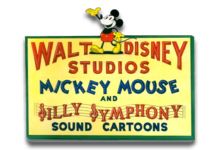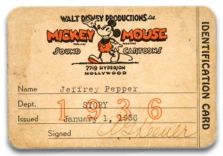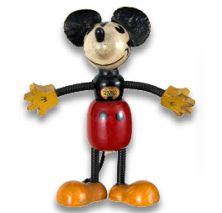
Six months later, and without the benefit of its truly spectacular 3D presentation, I still unequivocally love
Meet the Robinsons.
I was curious if I
had actually been overly influenced by those impressive three-dimensional bells and whistles. After two viewings of the film in its just-released DVD format, I can honestly say that I wasn't. As I noted in my earlier review here at 2719,
Meet the Robinsons is a wholly unconventional film, especially by Disney standards. It is easily off-putting to those quickly offended by its disjointed and sometimes non-linear storytelling and its on-the-surface exaggerated archetype characters. And while it is doubtful it will ever achieve a cult-like status akin to something like
The Nightmare Before Christmas, I don't believe it will be as readily dismissed as its other recent Disney animated contemporaries
Treasure Planet,
Home on the Range or
Chicken Little.
Meet the Robinsons was painted in broad, albeit digital strokes. Characters are extreme in their qualities and eccentricities, but not necessarily defined by their archetypes. If you are quick to dismiss what seems to be Lewis' simple search for family and acceptance, or Bowler Hat Guy's overplayed villainous buffoonery, then you do a disservice to the efforts of director Stephen Anderson and his fellow talents at Walt Disney Animation Studios. For it is the very different, yet intertwined journeys of Lewis and the diminutive Mike Yagoobian that ultimately transcend and compliment what would otherwise seem a wacky time travel adventure into family dysfunction.

Dwelling on past regrets or happily embracing the future. Celebrating failure as a catalyst to success or disavowing personal responsibility to validate a miserable and failed life. These are the challenges faced by Lewis and Goob. When we are first introduced to the two friends and roommates, the contrast in their personalities is distinct. Goob speaks a disjointed stream of consciousness that reflects his dreams of a future of baseball stardom, and demonstrates a lack of focus that will prove crippling and exploitable. At the same time, Lewis displays a quiet determination in constructing his latest invention, yet is crippled himself in his perceptions of failure and lack of forward thinking.
As we witness the reverse-evolution of Bowler Hat Guy back into his original incarnation as the young Mike Yagoobian, we become aware of a complexity of character rather than an over-the-top cliched archetype. Bowler Hat Guy's villainous swaggering exterior is methodically peeled away to reveal a still ingrained childhood mindset that is easily manipulated by an outside influence. When a defeated Goob teeters unknowingly on the precipice of his emotional destiny, it is his own future self that ultimately influences the path he takes:
 "No! Everyone will tell you to let it go and move on, but don’t! Instead, let it fester and boil inside of you. Take these feelings and lock them away. Let them fuel your actions. Let hate be your ally and you will be capable of wonderfully horrid things. Heed my words, Goob. Don’t let it go."
"No! Everyone will tell you to let it go and move on, but don’t! Instead, let it fester and boil inside of you. Take these feelings and lock them away. Let them fuel your actions. Let hate be your ally and you will be capable of wonderfully horrid things. Heed my words, Goob. Don’t let it go."
Little Mikey grows into a bitter and disappointed individual, easily manipulated by the inhuman and evil machinations of Doris, the true villain of the piece. But in that symbolic exchange, it was he himself who determined the path taken. It is a bold statement about the human condition and its propensity for self-corruption, surprisingly found in a film genre recently better known for flatulence-based humor and teen-pleasing innuendos.
Lewis' obsession with the past is however not so much rooted in regrets as it is in the desire for family and acceptance. But he finds those dynamics, not in a past memory of a long lost mother, but unexpectedly in the wacky spontaneous collective of the extended Robinson clan. In another similarly symbolic encounter, Cornelius Robinson reinforces his forward-moving mantra upon young Lewis, thereby ensuring the very future that he, Cornelius, has in fact created.
This subtle laying of emotional groundwork allows for a culmination of story and events into an ending both overwhelming in its heartfelt nature and unexpected in its sincerity. The film is in many ways presented as a scrambled puzzle where surprisingly, nearly every piece deftly falls into place before the end credits roll. The smallest of details are accounted for despite the usual paradoxical problems inherent to time travel storytelling. The film's final moments, devoid of dialog but set to Rob Thomas' performance of the song "Little Wonders," deliver a succession of character performances rich in emotional nuance and possessing a genuineness unexpected in their very scope and delivery.

Upon subsequent viewings, I noticed a number of subtle elements that were simply brilliant in their execution. The film's opening moments where an infant Lewis is placed on the steps of the Sixth Street Orphanage, is colored in deep sepia tones, much liked an aged photograph and in direct contrast to film's later presentation of a bright and multicolored future.
The roots of the hilarious dinner table martial arts movie confrontation between Frannie and brother Gaston can be found in the film's early science fair scene where Frannie tells future son Wilbur "Don't sass me boy, I know karate."
The differences between Lewis and Goob are demonstrated in a subtle but telling manner via Lewis' equation-filled composition book that plays in stark contrast to Goob's happy unicorn-themed binder and its simple one-page checklist. Despite the nefarious tasks scribbled on that first page of loose leaf paper, the simple joyful nature of the possession betrays an underlying goodness potentially buried beneath the Bowler Hat Guy's villainy. The hollow nature of the adult Goob's plans and motivations is succinctly summarized early in the film when the head of Inventco pointedly questions "You mean you haven't thought this through?" The film revisits this thesis both hilariously and directly via the manipulations of Frankie the frog and T-Rex who both submissively proclaim "I'm just not so sure how well this plan was thought through . . . . . . Master."

I especially loved the parallel visits to the Anderson Observatory by Lewis in both the future and the present. Much in the way Cornelius reveals to Lewis his future potential, Bud and Lucille similarly uncover his eyes to the empty area upon which that unbridled potential will be realized.
And I will without reservation make note of the film's overall testament to the creative philosophies of Walt Disney. Much like the film's conclusion, the end quote is an unexpected emotional surprise that reaches beyond just the specific life journey of Lewis/Cornelius Robinson. While Walt Disney may have not specifically proclaimed the Keep Moving Forward mantra, his suppositions on "pushing the envelope" and "everyone needs a good failure" are clearly the basis of the Robinson family creeds. The quote, for many of us, is a direct correlation as to why we are, and have been, passionate Disney fans and enthusiasts. And it in many ways speaks to the recent transformation of the Walt Disney Company under the collective leadership of Bob Iger, Ed Catmull and John Lasseter. Iger's own recent recent references to "generating creative success" certainly reflect the Keep Moving Forward philosophy, and certainly run counter to the Bowler Hat Guy planning that often defined the company prior to Iger's appointment as CEO.

As I've often stated, opinions are subjective.
Meet the Robinsons has its detractors, many of them among the self-proclaimed Disney faithful. They clearly did not have the patience nor tolerance for the unconventional approach to the material taken by director Anderson and his crew. But it was that very approach that set it apart so dramatically and refreshingly from the overabundance of animated product that currently fills the multiplexes and DVD store shelves. At least for me, it was a fun, emotionally-charged and highly satisfying ride into the future with a fitting and relevant tribute to the Walt Disney Company's creative past.




































































